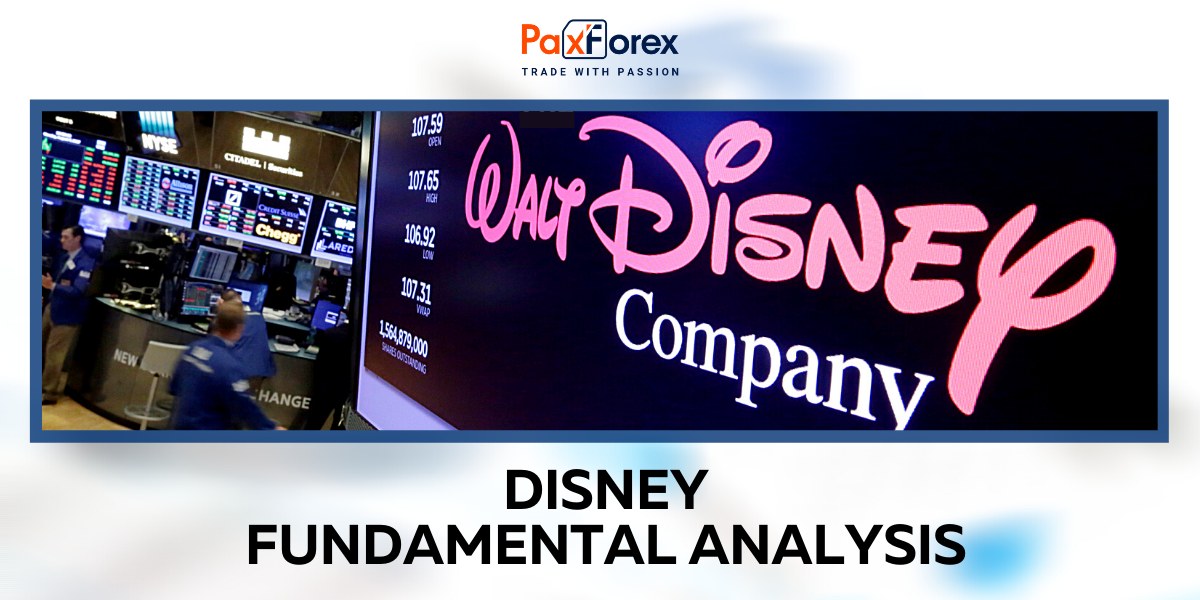
Source: PaxForex Premium Analytics Portal, Fundamental Insight
Despite being one of the world’s most recognizable media and entertainment giants, Walt Disney has faced significant challenges as an investment in recent years. A $1,000 investment in Disney shares five years ago would have yielded a disappointing return, with a 25% loss in capital value. For such a storied company, this performance might come as a surprise to many, especially given its unparalleled legacy in storytelling and brand recognition across the globe. However, there are compelling reasons to believe that better days are ahead for Disney, and that now may be an opportune moment for investors to consider adding Disney stock to their portfolios.
One of Disney's most valuable assets is its immense intellectual property (IP) portfolio. Disney possesses an extensive range of characters, franchises, and storylines that are cherished worldwide, giving the company a significant competitive advantage. The concept of an economic moat is key to identifying a resilient business, and Disney’s moat is undoubtedly one of the widest. With iconic franchises like Marvel, Star Wars, and Pixar under its umbrella, Disney has cultivated a deep, emotional connection with audiences that new competitors would struggle to replicate. This connection not only fuels the company’s primary revenue channels, such as movies and streaming, but also its downstream ventures, including theme parks, merchandise, and licensing deals. The unique value of this IP cannot be overstated; creating a comparable portfolio from scratch would require not just billions of dollars but also decades to build the same level of cultural resonance. The company’s special position in the industry makes it irreplaceable, providing an edge that should not be underestimated when evaluating its future potential as an investment.
Despite the recent struggles in its financial performance, Disney has been investing aggressively in its direct-to-consumer (DTC) streaming operations, a transformation that many believe is necessary for it to remain competitive in a rapidly changing media landscape. This shift has required substantial capital investment in both content production and technological infrastructure, which has weighed on the company’s short-term earnings. However, these investments are beginning to pay off. In Q3 of fiscal 2023, Disney’s DTC segment, which includes Disney+, Hulu, and ESPN+, finally posted positive operating income, marking an inflection point for the business. With 153.8 million subscribers, Disney+ has already become one of the leading platforms in the streaming industry, even in a highly competitive environment dominated by established players like Netflix and Amazon Prime Video. The success of Disney+ indicates that Disney has the ability to leverage its vast content library and brand power to attract and retain subscribers, a trend that bodes well for future profitability.
In addition, Disney’s ability to bundle Disney+ with other services, such as Hulu and ESPN+, provides the company with pricing flexibility and a unique value proposition for consumers. This bundling strategy not only enhances the appeal of its DTC offerings but also positions Disney favorably to capitalize on rising subscription prices without losing significant market share. Management has shown confidence that DTC earnings will continue to rise as operational efficiencies and cost-cutting measures come into effect. As the streaming segment becomes more profitable, it is likely to lift the overall profitability of the company, making Disney an even more attractive investment.
The current market sentiment surrounding Disney remains somewhat pessimistic, as evidenced by the stock being down 52% from its peak in March 2021. This decline reflects both the financial strain of Disney’s investments in DTC and the challenges posed by a highly competitive streaming landscape. However, for the patient investor, this situation presents an opportunity. As of now, Disney’s stock trades at a forward price-to-earnings ratio of 18.8, which is close to the cheapest level the shares have reached in the past three years and represents a notable discount relative to the S&P 500. Such a valuation is rare for a company with Disney’s brand power and intellectual assets, making it an appealing prospect for long-term investors who are willing to look past recent setbacks.
For investors with a three-to-five-year horizon, Disney’s combination of a strong economic moat, improving profitability in its streaming segment, and an attractive valuation presents a compelling case. While the road to full recovery may not be immediate, Disney’s unique strengths in intellectual property, coupled with its strategic shift toward direct-to-consumer services, position it well to deliver strong returns over the long term. In a market that often undervalues patience, Disney stands out as a stock that could reward investors willing to hold on through the company’s transformation journey.
As long as the price is above 92.00, follow the recommendations below:
- Time frame: D1
- Recommendation: long position
- Entry point: 94.76
- Take Profit 1: 98.00
- Take Profit 2: 102.00
Alternative scenario:
If the level of 92.00 is broken-out, follow the recommendations below:
- Time frame: D1
- Recommendation: short position
- Entry point: 92.00
- Take Profit 1: 89.00
- Take Profit 2: 86.00













